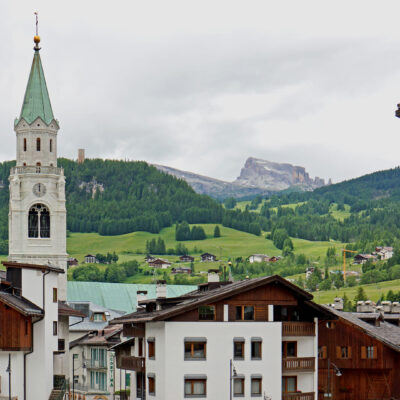Cortina d’Ampezzo

At the mere mention of its name, Cortina d’Ampezzo evokes a dimension that is suspended just above reality, a patina of gold enveloping breathtaking landscapes and international temples of luxury. The Cortina lifestyle has been entrancing our common imagination since the mid-20th century. Its peaks, ski resorts and the beauty of its excellent shopping areas make it a unique tourist destination for visitors seeking a high-altitude oasis. It is a snowy land on which extraordinary design spaces, showrooms, ateliers and boutiques flourish. Cortina d’Ampezzo is not, however, a haven of relaxation and luxury that differs from other similar ones just because of its altitude. This glamorous and glossy destination could exist solely in its exact location, because it was created upon the foundation of another Cortina that is still alive. A town with a strong identity, rooted in centuries and preserved with dedication and care by those who have lived there for generations. That the historical community of Cortina d’Ampezzo has a culture of its own can be seen and heard by their language. Along with Italian, the local population speaks “Ampezzano”, a variant of the broad Ladino language group, recognized as a true autonomous idiom. Of Latin descent, it is a Romance language that over time has become a symbol of an entire community. It is spoken even by the youngest members of the local population. In many public spaces and on signs in Cortina d’Ampezzo, it is written alongside Italian, and the locals claim it as their own with a great feeling of pride for those mountainous and rustic origins that are less evident today in the town’s architecture.
At the mere mention of its name, Cortina d’Ampezzo evokes a dimension that is suspended just above reality, a patina of gold enveloping breathtaking landscapes and international temples of luxury.
The modern history of Cortina d’Ampezzo, the glossy locale of the iconic postcards of a few decades ago, which is internationally known as a sophisticated destination because of how it has been portrayed at the cinema, came about just over half a century ago and is nurtured to this day. Before that, the village’s names first appeared side by side as “Curtina Ampitii” as early as the beginning of the 1300s. The area was subsequently dominated for centuries by the Roman Empire, the Hapsburg annexation, the French Empire, and then once again by the Hapsburgs who brought their lustre to the area. They all recognized a special autonomy to the small rural community of Cortina d’Ampezzo, which in the late 1800s began to experience its golden age. The Austrian-German nobility and the English upper middle class made it a trendy escape from the big cities, fueling the myth of Cortina d’Ampezzo as a high-class tourist destination even overseas. A gem in the Dolomites, that soon adapted to the high expectations and needs of the bourgeoisie of the time for both the summer and winter months, giving rise to luxury stores and hotels, major renovations of public spaces, and the famous ski facilities. The allure of the so-called Pearl of the Alps shone again just after World War II, when it spurred its own revival by bidding to host the 1956 Winter Olympics. From that moment, Cortina started a new era and entered the common imagination as an oasis of sophisticated and fascinating beauty, and it never left that place. Its legend made it one of the international capitals of winter tourism.
A gem in the Dolomites, that soon adapted to the high expectations and needs of the bourgeoisie of the time for both the summer and winter months, giving rise to luxury stores and hotels, major renovations of public spaces, and the famous ski facilities.
From 007 to The Pink Panther, its snowy backdrops have been featured in many compelling, romantic and dramatic stories portrayed on film. But the beauty of Cortina d’Ampezzo does not end at just the white snow-covered mountains. October and November are the months when foliage enthusiasts from all over the world gather in Cortina to admire the forest colours in unique tones of red, orange and yellow. Fiery foliage silhouetted against landscapes of blue-green peaks capable of taking your breath away. Lake Federa is definitely the most popular destination to observe this magical phenomenon, in total contact with nature and preserved in the most pristine way possible. But just as noteworthy is the walk to the Mietres Refuge, which starts at the Rio Bere stream and passes through the larch forest lit by the colours of autumn, until it reaches an open clearing where there is a 360-degree view of the magnificent Dolomite mountains.
The natural settings represent the town’s historical and original soul, but Corso Italia is definitely the representation of modern Cortina d’Ampezzo and its lifestyle, with the historic “temples” of luxury brands. Alongside them there are new spaces of contemporary excellence: new and sought-after showrooms are now on the famous street that runs through the city. They bring new inspiration in the form of art, galleries, designers and unique pieces, for a clientele that is the pinnacle of international taste.
At the mere mention of its name, Cortina d’Ampezzo evokes a dimension that is suspended just above reality, a patina of gold enveloping breathtaking landscapes and international temples of luxury.